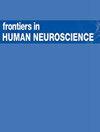对前小脑连接网络的θ脉冲刺激可提高简单认知任务中的认知处理速度
IF 2.4
3区 医学
Q3 NEUROSCIENCES
引用次数: 0
摘要
背景前额-小脑功能网络被认为是认知处理速度的辅助网络。本研究旨在阐明长程额叶-小脑有效连接如何有助于提高速度。方法:60 名健康参与者被随机分配到三种经颅磁刺激条件下,即间歇θ-脉冲刺激(iTBS,兴奋性)、连续θ-脉冲刺激(CTBS,抑制性)或假刺激条件下,每天三次,每次五次。刺激部位分别为右侧补充运动前区(RpSMA)、小脑内侧蚓部VI(MCV6)和顶点。结果 刺激后,简单任务的速度略有下降,复杂任务的速度则没有下降。然而,在简单反应时间(SRT)任务中,兴奋性 RpSMA 和抑制性 MCV6 条件下的参与者与假条件下的参与者相比,在速度更快方面表现出直接的负路径效应(分别为 β = -0.320,p = 0.045 和 β = -0.414,p = 0.007)。讨论RpSMA和MCV6参与了促进简单认知任务中更快反应时间的路径效应。这项研究提供了进一步的证据来支持它们在长程额叶到小脑连接中为认知处理速度服务的作用。不过,这种增强效应可能仅限于简单而非复杂的心理操作。本文章由计算机程序翻译,如有差异,请以英文原文为准。
Theta burst stimulation on the fronto-cerebellar connective network promotes cognitive processing speed in the simple cognitive task
BackgroundThe fronto-cerebellar functional network has been proposed to subserve cognitive processing speed. This study aims to elucidate how the long-range frontal-to-cerebellar effective connectivity contributes to faster speed.MethodsIn total, 60 healthy participants were randomly allocated to three five-daily sessions of transcranial magnetic stimulation conditions, namely intermittent theta-burst stimulation (iTBS, excitatory), continuous theta-burst stimulation (CTBS, inhibitory), or a sham condition. The sites of the stimulations were the right pre-supplementary motor area (RpSMA), medial cerebellar vermis VI (MCV6), and vertex, respectively. Performances in two reaction time tasks were recorded at different time points.ResultsPost-stimulation speeds revealed marginal decreases in the simple but not complex task. Nevertheless, participants in the excitatory RpSMA and inhibitory MCV6 conditions showed direct and negative path effects on faster speeds compared to the sham condition in the simple reaction time (SRT) task (β = −0.320, p = 0.045 and β = −0.414, p = 0.007, respectively). These path effects were not observed in the SDMT task.DiscussionRpSMA and MCV6 were involved in promoting the path effects of faster reaction times on simple cognitive task. This study offers further evidence to support their roles within the long-range frontal-to-cerebellar connectivity subserving cognitive processing speed. The enhancement effects, however, are likely limited to simple rather than complex mental operations.
求助全文
通过发布文献求助,成功后即可免费获取论文全文。
去求助
来源期刊

Frontiers in Human Neuroscience
医学-神经科学
CiteScore
4.70
自引率
6.90%
发文量
830
审稿时长
2-4 weeks
期刊介绍:
Frontiers in Human Neuroscience is a first-tier electronic journal devoted to understanding the brain mechanisms supporting cognitive and social behavior in humans, and how these mechanisms might be altered in disease states. The last 25 years have seen an explosive growth in both the methods and the theoretical constructs available to study the human brain. Advances in electrophysiological, neuroimaging, neuropsychological, psychophysical, neuropharmacological and computational approaches have provided key insights into the mechanisms of a broad range of human behaviors in both health and disease. Work in human neuroscience ranges from the cognitive domain, including areas such as memory, attention, language and perception to the social domain, with this last subject addressing topics, such as interpersonal interactions, social discourse and emotional regulation. How these processes unfold during development, mature in adulthood and often decline in aging, and how they are altered in a host of developmental, neurological and psychiatric disorders, has become increasingly amenable to human neuroscience research approaches. Work in human neuroscience has influenced many areas of inquiry ranging from social and cognitive psychology to economics, law and public policy. Accordingly, our journal will provide a forum for human research spanning all areas of human cognitive, social, developmental and translational neuroscience using any research approach.
 求助内容:
求助内容: 应助结果提醒方式:
应助结果提醒方式:


